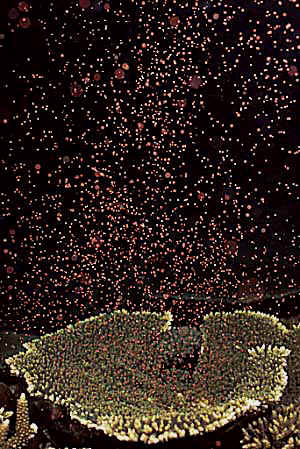There are a lot of sperm and embryos frozen in the DC metro area. Every morning on my drive into work, I hear an ad for one of the many local institutes that combat infertility to help couples "realize their dream of having a baby". It is also becoming popular (and somewhat controversial) for our soldiers to store sperm before deploying to war zones.
The National Zoo has another set of repositories for sperm and embryos, to instead combat declining biodiversity. One of their repositories specifically targets corals from the Great Barrier Reef. The idea is that embryos could be thawed, reared in the lab and then transferred onto the reef to add genetic diversity, help boost potentially dwindling numbers, or even reintroduce an extinct species. Similarly, sperm could be thawed to fertilize fresh eggs adding potentially extinct genotypes back into the wild population.
In theory, this sounds like a great insurance policy. However, this isn't just a seed bank for crops that humans have developed and selected for over thousands of years that will be sewn into a controlled field. We're talking about wild populations with some complex symbioses. Will evolving populations and a changing climate make the stored genotypes inferior?
Its no wonder that the Zoo has targeted tropical corals. They have impressive displays of synchronized spawning (see picture and video). Most importantly, they have been a 'canary in the coal mine' and thus a poster child for effects of climate change in the ocean. Ocean warming coupled with other factors such as pollution, fishing and disease, causes coral bleaching - where the corals loose their algal symbionts. These algae living within the coral tissue and, in exchange for protection and nutrient delivery, share their sugars made by photosynthesis with the coral host. When the coral loose the algae, called zooxanthelle, they turn white (bleach) and die. Furthermore, the pH of the ocean is dropping. This ocean acidification could hamper fabricating the coral skeleton. Global warming and ocean acidification are threatening the highly productive and diverse coral reef ecosystems around the world.
The evolutionist in me must point out these processes will also apply selective pressures on the coral and symbiont populations. Thus, attributes of the two populations are likely to adapt to changing conditions through natural selection. Alternatively, species will become extinct.
In the case of adaptation, reintroducing sperm or embryos from the past may be introducing inferior individuals and genotypes. This could reverse or dilute some of the adaptive genotypes. If corals and their algal symbionts co-evolve, the cultured and reintroduced coral larvae may not be able to acquire their necessary symbionts and die.
In the case of extinction, reintroducing a species that has disappeared will only work if the environment has been returned to favorable conditions. Otherwise this is an exercise in futility, as the species is likely to once again perish.
Thus, I believe that the most important goal should be conservation efforts to maintain and improve the health of the ecosystems. We can preserve genetic and species diversity in the lab through cryogenic freezing of sperm and embryos; but these preservation efforts will mean little unless the future environment is healthy and appropriate to support them in the wild.

No comments:
Post a Comment